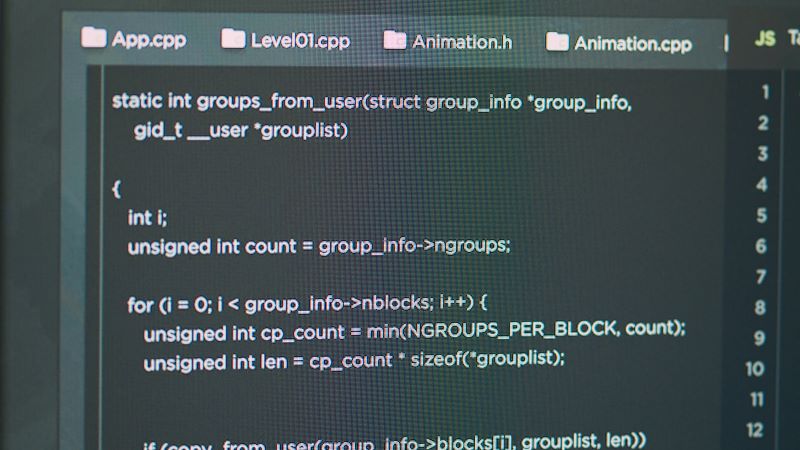What is Groovy Programming Language Used For?
The Groovy programming language, sometimes referred to as Groovy scripting, is a valuable tool, but knowing how to use it – if you have never used any programming language – is not easy. To help you, this Groovy programming language tutorial takes a complex topic and aims to make it easy to learn and applicable to real-world situations.
With this Groovy programming tutorial, you will learn what it is, how it works, and when to use it. We include what you need to start applying it to your specific needs and goals.
An Overview of the Groovy Programming Language

Groovy programming language is an object-oriented programming language. It is commonly used for the Java platform. It can be both a static and a dynamic language.
You may find that Groovy functional programming is highly effective and efficient. It has some of the features you may be used to seeing in Python, Ruby, Perl, and Smalltalk. You can use it either as a programming language or a scripting language for Java.
Groovy Programming Language Used For?
The Groovy programming language is used for a wide range of tasks because of its numerous features. That includes DSL support, dynamic typing, and closures. Considering these assets, look at a few ways that you can use Groovy within real-world situations today (we’ll get into more details about how to do so in just a bit):
- Manage complex systems
- Automate numerous everyday tasks that take up much of your time
- Use it for web development
- Count on it for data processing and analysis when functional programming
- Use it as a testing-oriented programming language
- Apply Groovy scripting or more complex aspects
- Build domain-specific languages (DSLs)
- Use it for prototyping applications
- Speed up the application development process
Today, time is everything in the development of applications, websites, or other tools. That is, you need something that is fantastically capable of meeting your business objectives, but you also need to be fast and ready to go in no time. Groovy programming language does a great job of eliminating complications to make the entire process easy to master.
Why You Should Invest in a Groovy Programming Tutorial

Learning about it through this Groovy programming language tutorial will allow you to decide if you should apply this language to your next task. Is it just another language to learn and use? Yes, but there are some excellent reasons why you should learn how to use this particular language.
One of the benefits of using Groovy is that it can simplify Java coding. It is also beneficial for automating numerous types of recurring tasks. If you struggle with DSL modeling, Groovy can help make it a bite asier to manage. Also, note that Groovy supports ad-hoc scripting.
Groovy cannot replace Java. However, when you apply information and insight learned here, you will find that Groovy will build onto what Java can do for you.
Is Groovy just a scripting language?
Don’t make the mistake of believing Groovy is just a scripting language. It certainly provides those functions as one core component it offers. However, it does a great deal more, including pre-compiling it into a Java bytecode. It can also integrate into various applications, including those that are Java-based. You can also use it as the foundation for a whole new application.
The versatility that Groovy brings to projects makes it worth learning more about. When you write a program in Groovy, you harness all of the benefits and power of the Java platform – using every feature Java offers, including huge libraries – and you get more support and guidance along the way.
Now that you know the value of learning Groovy programming language, let’s explore the process. This basic guide and tutorial give you everything you need to get started.
The Features of the Groovy Programming Language
When you consider how to use Groovy programming, it helps to know what key features are available that you can adopt into your next project. It has the following features:
- Static and dynamic typing support
- Operator overloading support
- Native syntax to use for lists and associative arrays
- Native support for regular expressions
- Extension of the java.lang.Object
- Use all existing Java libraries as you need to
- Native support for numerous markup languages, including both HTML and XML
Remember, it also offers some powerful features including closures, builders, runtime, and compile time meta programing, and much more. If you have not done so yet, make sure you check out the Groovy Language website for specific insights into what this multi-faceted language can do for you.
Groovy Programming Tutorial – Environment

Is Groovy a programming language? Yes, it provides everything you need to best utilize the Java platform. One key question many have is about the environment. There are numerous ways to get the Groovy environment setup.
The most direct way is to get the binary download and installation. You can do that by going to the Windows Installer Section at www.groovy-lang.org/download.html. That will give you the option to download the installer. Follow the on-screen instructions from that point to get the environment.
Once you go through a series of steps you can then start the Groovy Shell, which helps with testing.
If you are hoping to include Groovy binaries as a part of your maven or grade build, you will use the following lines:
‘org.codehaus.groovy:groovy:2.4.5’
,groupId.org.codehaus.groovy</groupId><artifactID.groovy</artifactID.<version>2.4.5</version>
For the most recent Maven plugin, visit this link.
Groovy Programming Language Tutorial: Basic Features

When you consider what Groovy programming is used for, the best way to understand the versatility of this programming language is to check out its features. Let’s breakdown some of the key features that you should be incorporating into your application.
Remember, Groovy, unlike other languages, cannot replace Java. However, it differs from Java and can be an excellent way to build from the Java foundation.
Dynamic typing in Groovy
One of the most common reasons people turn to this language is for the dynamic typing. Languages that are dynamic move type checks from compile-time to run-time.
Type safety includes managing type mismatch errors within a programming language, and you can enforce type safety at compile time or run-time.
In Java, which uses static typing, you have to give a data type to each variable defined. This leads to complicated code, and a type mismatch error is likely to occur if the type assigned to the variety and the one assigned to the value don’t match.
That means you cannot assign a String valuable to a variable that is an integer (int). With Groovy, it lets you defer specifying the data type of the variable until later, at run-time. This gives you more of the flexibility you may need.
Groovy is object-oriented
When you use Groovy scripting, you can benefit form all the object-oriented properties that are available in Java. That means that, with this tool, you can create classes, call class methods, as well as set priorities and instantiate class objects.
Truthy conversion
Another key element of Groovy is that it evaluates each object to a Boolean if necessary. This may be necessary, for example, when using it inside an if statement or when negating the value.
For example:
If(“hello”) {…}
If(someOjbect) {…}
When it comes to this conversion, there are a few things you must consider and apply. Non-empty Collections, arrays, and maps evaluate to true. Matcher with at least one match evaluates to true.
Iterators and Enumerations with more elements are coerced to true, and non-empty Strings, GStrings, and CharSquences are coerced to true.
Non-zero numbers are evaluated to true and non-null object references are coerced to true.
Key Features to Consider in Groovy Programming Language
There are dozens of very cool features that can play a role in the work you do with Groovy, and it is certainly worth taking a closer look and applying them. Some of the most interesting are the basics. Consider these.
Consider this example that you have probably seen before:
Println “Hello World.”
When you are using Groovy programing language, there is no need to use a semicolon or a parenthesis (that makes things easier right?)
Even if you use System.out.println (in Java), it is reduced to simply println.
What you will find is that this is a super time saver for those who may not write code daily but need solutions that are effortless (and less risky to mess up!)
There is no need to import packages
Another feature is that Groovy does not require importing packages or making it mandatory to specify data types.
Other features
Before moving on, to see what Groovy programming language is used for, check out these features:
- It supports closures.
- It generates setters and getters automatically at the point of compile. This is called Plain Old Groovy Object, or POGO.
- Working with Lists and Maps is simple in Groovy.
How to Run Groovy: A Basic Groovy Programming Tutorial to Get Started

Your first step is to ensure you have Java Runtime Environment (JRE) in place. It needs to be Java versions 6, 7, or 8. You can get Java’s latest version without any cost to you.
Once you have Java in place (and updated as necessary), the next step is to simply set the JAVA_HOME environment. (We discussed this briefly above). Because Groovy does change over time, you’ll want to follow the latest information and updates on the site to make sure that you are using the best possible version.
Once you install Groovy, you can then run it directly as script. To do this, use:
- “groovy”
- “groovysh”
- “groovyConsole”
- “groovyc”
There are also plug ins that you can use to help you with the process as well. Getting startd only take sa few minutes and it is a forgiving system (you do not have to be a programmer with years of knowledge to get this right!)
How to Use Groovy Scripting – Your Groovy Functional Programming Tips

The versatility and features of Groovy scripting make it quite an interesting tool. There are numerous ways that you can adapt it to fit your goals.
POGO
One of the ways to use Groovy is to pair it with Java programming. Java is widely accepted and loved, and it can be hard to encourage anyone to actually apply a new programming language to the mix. However, Groovy does a great job of supporting you.
You can introduce dynamic behavior to your existing Java code. At the same time, you’re keeping the process super concise.
When you compare the steps in writing with Java alone to using Groovy, you can take five-10 lines of programming language down to about 2.
Groovy offers support for functional programming as well as metaprogramming. This allows you to write in a concise manner with expressive code while still working within the Java libraries and frameworks.
Automation in Groovy
Another way to use Groovy programming language is to automate repetitive tasks that tend to take time out of your day, every day. For example, it can aid in extracting data from a data source. You can also use it to generate your daily sales report or gather very specific data. Use it for processing a batch file.
Groovy scripting benefits developers because of its built-in scripting abilities. This makes your job easier to manage.
Here is one way it can be beneficial in this application. Let’s say you are an Agile programmer. Your work requires the management of numerous statuses and cards across various workflows. It is a lot of tedious work with numerous steps. Groovy can help with this. You can build a simple automation for the task you want to stop having to deal with yourself. It can also pull up continuous integration and reporting capabilities if those fit your specific situation better.
Also, many people find that one of the best uses of automation with Groovy is for testing. Use it for all of your testing needs, including both unit and functional testing.
Integrations with Groovy Scripting are easy
Let’s face it – you do not want to give up the tools you are already using and feeling great about using. The good news is that with Groovy language programing, the netire process is versatile. You can use various integrations alongside Groovy to enhance the outcome.
APIs are often one way to manage integrations. However, they are never simplistic, even in the most ideal world. Groovy can help you to simplify this process. You can integrate with RESTful APIs, as well as SOAP services, and others with ease.
Groovy enables this because it has built-in support for JSON, HTTP, XML, and others. This makes it very easy for you to manipulate the data.
Also beneficial is that Groovy has features that support the use of SQL and JDBC, so if you need to integrate with Oracle, MySQL, or PostgreSQL, that’s easier to do than ever with this tool. Also helpful is that you can use it to extract data to various reports.
Why does this help Groovy to stand out? Most programmers face the complexity of conflicting messages and formatting. With dynamic typing, a feature provided by Groovy, you have more flexibility to work within any of these or other formats. This allows users to apply it to technologies like Apache Camel, Apache Kafka, or RabbiMQ.
Another nice integration feature is within cloud applications. We have all seen the demand for cloud applications skyrocket recently. Google Cloud, Azure, and AWS, are just some of those in-=demand solutions. With Groovy, you can integrate into each of these. You can also use it to integrate into ServiceNow, Zendesk, Jira, Azure DevOps, Salesforce – the list goes on.
Need more?
You can use Groovy scripting for enterprise integrations as well. This includes tasks like data integration, application integration, and ETL. The benefit here is that you can use its functional programming and collection features, along with tapping into Java libraries and frameworks to enhance the work you are doing. It actually becomes a very powerful resource for you.
These are some of the best ways to use Groovy programing language and Groovy scripting, but it is far from the whole picture.
How Groovy Supports Java: Is Groovy a Programming Language You Need?

Many people are Java lovers. They know it, they practice it, and they cannot think about replacing it. With Groovy, you do not have to replace it but what you do get is a way to enhance it. Let’s look at a few more ways that Groovy programing language and scripting can actually complement the way you are using Java.
The first benefit is that anyone using Java will not find Groovy to be a challenge. It is made to make the language easier to use. Remember, you have access to the libraries and frameworks that you like to use in Java. Because these two languages share syntax and sematics, or close to it, that means you can easily adopt Groovy into your current workflow without limitations. Groovy goes further, building on top of Java.
Here are some of the ways that Groovy programming language actually makes Java better.
Avoid imports
This is a big deal. When you use Groovy, you do not need to incorporate an important statement. Instead, Groovy imports a few packages. Their default classes include:
- java.lang.*
- java.math.BigDecimal
- java.math.BigInteger
- java.util.*
- groovy.lang.*
- groovy.util.*
By extending the java.lang.Object class, you gain access to all of the Java-related tools and benefits you want and need.
Arrays in Groovy
When you are initializing arrays in Java, you are using curly brackets to do it: {…}
Groovy only uses curly brackets for closures. That means you need to initialize arrays using square brackets instead.
Here is a simple example:
def animals = [“Tiger”, “Lion”, “Giraffe”] as String[]
Groovy syntax is short
As we mentioned earlier, Groovy does a great job of keeping things concise. It does not remove the language benefits and features, or functions, but it does a great job of minimizing it.
Look at the following example Java code that is pretty standard:
import java.io.BufferedReader;
import java.io.FileReader;
import java.io.IOException;
public class FileProcessor {
public static void main(String[] args) throws IOException {
BufferedReader reader = new BufferedReader(new FileReader(args[0]));
String line;
while ((line = reader.readLine()) != null) {
System.out.println(line);
}
reader.close();
}
}
That certainly takes some time to write up. However, with Groovy scripting, it comes down to just this (yes, just this):
new File(args[0]).each line { line ->
println line
}
Dynamic typing in Groovy
We’ve mentioned this a few times because, frankly, it matters. What is the difference:
- Dynamically typed languages: The type checking occurs at run time – this is what Groovy does.
- Statically typed languages: The type checking is done at compile time – this is what Java does on its own
Where to Use Groovy Programing Language in Your Operation
With this basic Groovy programming language tutorial, you can see the benefits and applications of using Groovy. But where and how does this work within your day-to-day tasks? Consider the following use cases for Groovy scripting specifically:
- Data processing: It is an excellent choice for data processing and analysis thanks to features like higher-order functions, collections, and closures.
- Automation: It gets rid of the repetitive tasks that are so common with Java that take up too much of your time. You can simplify virtually any type.
- Testing: Use it to test your programming language within a safe environment.
- Build DSLs: Use it to build DSLs. One of the best examples of this is Gradle.
- Get apps up and running faster: The concision of this tool makes it easy to write compact and readable code that gets your project up and working in no time.
Let Rayobyte Take You to the Next Level

There are so many exceptional benefits to using Groovy programming language. Nevertheless, you may also benefit form having a team to help you manage the entire process for you including setting up proxies and managing your next project. Contact Rayobyte now to learn more about how we can help you.
The information contained within this article, including information posted by official staff, guest-submitted material, message board postings, or other third-party material is presented solely for the purposes of education and furtherance of the knowledge of the reader. All trademarks used in this publication are hereby acknowledged as the property of their respective owners.






